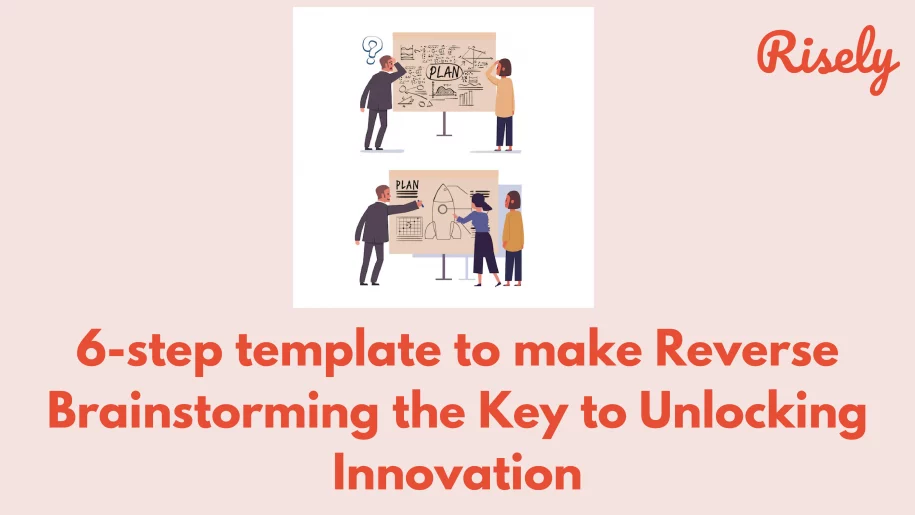6-step template to make Reverse Brainstorming the Key to Unlocking Innovation
As an innovator, you know that brainstorming is a crucial part of the creative process. But have you ever tried reverse brainstorming? This technique flips traditional brainstorming on its head and helps generate innovative solutions by focusing on the opposite approach. In this blog, we explore reverse brainstorming, how to incorporate it into your team’s creative process, and the benefits and drawbacks of this technique. We’ll even provide you with a reverse brainstorming template to get you started. Then, join us as we walk you through real-world examples of this method and explore why reverse brainstorming may be the key to unlocking innovation.What is Reverse Brainstorming?
Reverse brainstorming is a creative problem solving technique that involves looking at a problem from a different perspective. Instead of thinking about solving a problem directly, reverse brainstorming encourages you to brainstorm ideas to make the situation worse. By doing so, you can identify the problem’s root causes and develop alternative solutions. To use this technique, you start by defining the problem you want to solve. Then, instead of generating solutions to the problem, you think of ways to make the situation worse. This approach can help you identify the problem’s underlying causes and stimulate creative thinking. Once you have a list of ways to make the situation worse, you can flip them around and brainstorm solutions to prevent those adverse outcomes from happening. Reverse brainstorming can be especially useful when dealing with a problem that has already been approached from traditional angles and no solution has been found. It can help you to break out of a rigid mindset and find innovative solutions that might not have been considered otherwise.The Advantages of Reverse Brainstorming
Brainstorming done in reverse offers several advantages over traditional brainstorming techniques:- Encourages creative thinking: Reverse brainstorming encourages you to think outside the box and develop unconventional ideas. You can uncover unexpected solutions you might not have thought of otherwise by considering ways to make the problem worse.
- Helps identify root causes: By considering how to make the situation worse, you can identify the root causes of the problem. This can help you to develop more effective solutions that address the underlying issues rather than just treating the symptoms.
- Generates a wide range of solutions: Reverse brainstorming can generate many solutions that might not have been considered in traditional brainstorming. You can flip them around to create positive solutions by starting with negative outcomes.
- Promotes teamwork: Reverse brainstorming can be done in a group setting, encouraging collaboration and teamwork. By working together to generate ideas, team members can build off each other’s ideas and develop more effective solutions.
- Increases engagement: Reverse brainstorming can be a fun and engaging activity that promotes participation from all team members. By challenging team members to think in new ways, reverse brainstorming can increase engagement and enthusiasm for problem-solving.
Other Interesting Reads
The Disadvantages of Reverse Brainstorming
While reverse brainstorming has several advantages, it also has some potential disadvantages:- Can be time-consuming: It requires time and effort to identify negative outcomes and flip them into positive solutions. This process can be time-consuming and require multiple iterations before arriving at a feasible solution.
- It may be challenging for some: Some individuals may find it difficult to think about negative outcomes, which can hinder their ability to participate fully in the reverse brainstorming process.
- May generate unrealistic ideas: Because reverse brainstorming encourages you to think in unconventional ways, it may generate unrealistic or impractical ideas that are not feasible to implement.
- It may not work for all problems: Reverse brainstorming may not be effective for all types of issues. It is beneficial for problems where traditional solutions are ineffective but may not be as effective for more straightforward matters.
- Requires creativity: Reverse brainstorming requires a certain level of creativity and innovation to identify negative outcomes and flip them into positive solutions. Some individuals may struggle with this approach if they do not consider themselves particularly creative.
Reverse Brainstorming Template
Reverse brainstorming aims to generate unconventional ideas that can lead to innovative solutions. Encourage participants to think creatively and challenge assumptions to develop the most effective solutions possible. Here’s a template that can be used for it:- Define the problem: Clearly state the problem that you want to solve. This could be a business challenge, a customer issue, or a personal problem.
- Identify negative outcomes: Brainstorm ways to make the situation worse. Encourage participants to think creatively and develop as many negative outcomes as possible. Write these negative outcomes down on a sheet of paper or whiteboard.
- Analyze negative consequences: Examine each negative result and identify the underlying causes. Ask questions such as, “What is causing this negative outcome to happen?” and “What factors are contributing to this problem?”
- Flip negative outcomes into positive solutions: Once you have identified the root causes of the problem, flip each negative effect around into a positive resolution. Ask questions such as, “What would be the opposite of this negative outcome?” and “How can we prevent this negative outcome from happening?”
- Evaluate and prioritize solutions: Review the list of positive solutions and evaluate their feasibility, cost, and potential impact. Prioritize the solutions based on their importance and the resources available.
- Take action: Once you have identified the most promising solutions, take action to implement them. Assign responsibilities, set deadlines, and track progress to ensure solutions are implemented effectively.
Examples of Reverse Brainstorming
Reverse brainstorming is a technique that involves generating negative ideas to find solutions to a problem. Taking the opposite approach can help identify potential issues before they arise. It involves asking questions like “What could be done to jeopardize the goal?” or “What could we do to make the situation worse? Here are four examples of how brainstorming in reverse can be used in the workplace:- Improving customer service: Suppose a company has received numerous complaints about its customer service. In a reverse brainstorming session, employees could generate ideas to make the customer service experience worse, such as being unresponsive, giving incorrect information, or being rude. These negative outcomes could then be flipped around to generate positive solutions, such as improving response times, training employees on accurate information, and promoting a culture of empathy and respect.
- Reducing waste: In a manufacturing environment, reverse brainstorming can be used to identify ways to increase waste and inefficiency in the production process. This could include using outdated equipment, ignoring maintenance schedules, or failing to train employees properly. Once these negative outcomes have been identified, they can be flipped around to generate solutions such as investing in modern equipment, implementing regular maintenance schedules, and training employees.
- Improving teamwork: If a team is struggling to work together effectively, reverse brainstorming can be used to identify ways to exacerbate the problem. This could include withholding information, refusing to collaborate, or criticizing team members openly. Once these negative outcomes have been identified, they can be flipped around to generate positive solutions, such as encouraging open communication, setting clear expectations, and providing team-building activities.
- Boosting sales: Suppose a company is experiencing a slump in sales. In a reverse brainstorming session, employees could generate ideas to make the company’s products or services less appealing to customers, such as reducing quality, raising prices, or decreasing customer support. These adverse outcomes could then be flipped around to generate positive solutions, such as improving product quality, offering competitive pricing, and providing excellent customer support.
Conclusion
Reverse brainstorming is a valuable tool that helps team members approach problems from a fresh perspective, break up existing assumptions, and stimulate new thinking. It ensures that everyone has a voice and allows for more creative solutions to emerge than traditional problem-solving methods. It helps you foster a more open-minded, optimistic, and diverse thinking environment while enabling you to think more critically about your ideas. To ensure your team gets the most out of reverse brainstorming, follow our template, tips, and real-world examples. Get started on unlocking your team’s innovation potential now.Learn more about your problem-solving abilities now with a free assessment.
The free problem solving assessment helps managers and leaders overcome errors that hold them back.
Frequently Asked Questions
What can reverse brainstorming be used for?
It can generate creative solutions by identifying potential problems or obstacles and brainstorming ways to avoid or prevent them. This technique can be helpful in problem-solving, innovation, and planning in various areas, such as business, education, and personal development. It can also help teams think outside the box and develop fresh ideas.
What are the two methods of brainstorming?
The two main methods of brainstorming are individual brainstorming and group brainstorming. Individual brainstorming involves developing ideas independently, while group brainstorming involves sharing and building upon ideas as a team. Each method has its advantages, and choosing the right one depends on the specific project and the goals of the brainstorming session.
What is the golden rule of brainstorming?
The golden rule of brainstorming is to withhold criticism and judgment and encourage free-flowing ideas. This means that all opinions are accepted and recorded without any evaluation or criticism, as it helps to create a comfortable and open environment for creativity. Once all the ideas have been listed, then it’s time to evaluate and refine them.
Other Related Blogs
Top 15 Tips for Effective Conflict Mediation at Work
Top 15 Tips for Effective Conflict Mediation at Work As a manager or leader, you might be familiar with the conflicts that arise in the workplace. It’s not always easy…
Top 10 Games for Negotiation Skills to Make You a Better Leader
Top 10 Games for Negotiation Skills to Make You a Better Leader Negotiation skills are essential in today’s workplace and can be honed through various methods. One fun and effective…
Manager Effectiveness: A Complete Guide for Managers in 2024
Manager Effectiveness: A Complete Guide for Managers in 2024 Manager effectiveness is everyone’s favorite buzzword. But the road to achieving it is trickier than it looks like! While manager effectiveness…
5 Proven Ways Managers can Build Collaboration in a Team
5 Proven Ways Managers can Build Collaboration in a Team In today’s fast-paced world, team collaboration is the key to success. But, not all workplaces are conducive to collaborative teams.…


